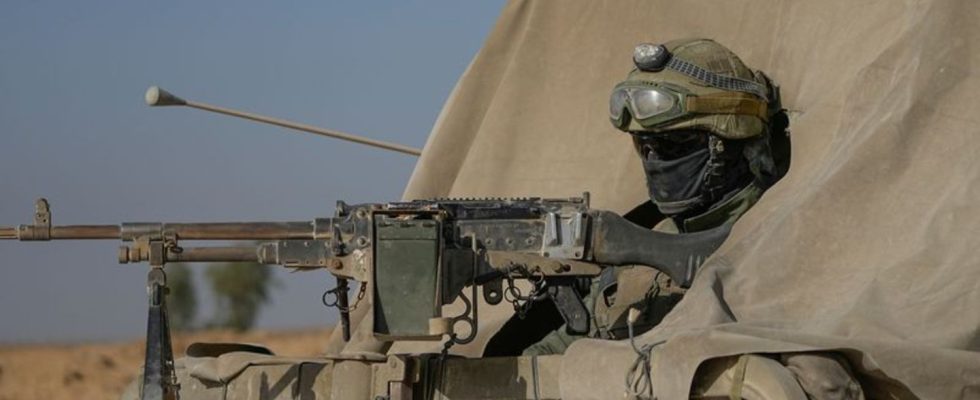War in the Middle East
Ceasefire in the Gaza war has come into effect
Israeli soldiers are deployed near the border with the Gaza Strip in southern Israel. photo
© Ohad Zwigenberg/AP/dpa
The agreed ceasefire in the Gaza war has been in effect since morning, but will it last? The fighting continued until the end – and will continue after the ceasefire. The overview.
The fighting continued until the end. In the Israeli border area with the Gaza Strip, there were rocket alarms immediately before the start of the ceasefire and again shortly afterwards, as had been the case during previous ceasefires. The Israeli army had previously intensified its attacks in the Gaza Strip and will keep its soldiers stationed there during the break in fighting.
Hostages are expected to be released at 3 p.m
At 4:00 p.m. local time (3:00 p.m. CET), the first 13 hostages held in the Gaza Strip are to be released as part of the agreement between Israel and Hamas. They are women and children. In return, three Palestinian prisoners will be released from Israeli prisons for each hostage. This is also about women and minors.
With the ceasefire – almost seven weeks after the start of the war – there should also be more aid deliveries for the suffering civilian population in the Gaza Strip. According to UN figures, more than 1.7 million people there, or around three quarters of the population, are now internally displaced. The UN Palestinian relief agency UNRWA wants to use the pause in fighting to distribute urgently needed relief supplies.
Israel announces further operations in the Gaza Strip
During the ceasefire, all sides would stop their military activities, announced a spokesman for the Qassam Brigades, which forms the armed wing of the Islamist organization Hamas. According to the Israeli military, after the intensive fighting has temporarily ended, there will continue to be many operations in the Gaza Strip until there is no longer a military threat from there.
An Israeli army spokesman wrote in Arabic on X, formerly Twitter, shortly before the ceasefire began: “The war is not over yet.” The northern Gaza Strip remains a “dangerous war zone” and it is forbidden to move back and forth there. Palestinians should remain in a “humanitarian zone” in the south of the coastal strip. However, it is still possible for civilians to move from the north to the south. In the other direction this is forbidden.
Number of deaths in the Gaza Strip
According to Hamas, the number of Palestinians killed in the Gaza Strip has risen to almost 15,000 since the war began almost seven weeks ago. More than 36,000 people were injured, the government press office of the Islamists in Gaza said on Thursday evening. The majority of them are children, young people and women. Thousands of people are still missing. The numbers cannot currently be independently verified.
The latest Gaza war was triggered by the worst massacre in Israel’s history, which terrorists from Hamas and other extremist groups committed on October 7th in Israel near the border with the Gaza Strip. On the Israeli side, more than 1,200 people were killed, including at least 850 civilians. Around 240 hostages were taken to Gaza, including several Germans.
According to the agreement between Israel and Hamas, a total of 50 hostages are to be released within four days. Overall, the agreement reached between both parties to the conflict provides for an exchange of up to 100 hostages from Israel for up to 300 Palestinian prisoners.
Hundreds of Palestinians want to go to the north of Gaza
Meanwhile, according to eyewitnesses, hundreds of Palestinian internally displaced people set out to return to their homes. People in the city of Gaza and other parts of the northern Gaza Strip wanted to check on their houses or apartments and their relatives, it was said in the morning. However, the Israeli military warned that it was forbidden to move from the south to the north of the coastal area.
The Israeli army had already warned before the ceasefire began that the war was not over. The northern Gaza Strip remains a “dangerous war zone” and it is forbidden to move back and forth there. Palestinians should remain in a “humanitarian zone” in the south of the coastal strip. However, it is still possible for civilians to move from the north to the south. Israeli television reported that “demonstration dispersal means” should be used if necessary to prevent people from coming from the south to the north.
Eyewitnesses reported in the morning that the Israeli Air Force had stopped its flights over the southern part of the Gaza Strip. Thousands of Israeli soldiers remain in the north of the sealed-off coastal area during the ceasefire.
What will be important on Friday
The first Israeli hostages are expected to be released at 3 p.m. German time. The ceasefire is intended to bring larger aid deliveries to the Gaza Strip.

